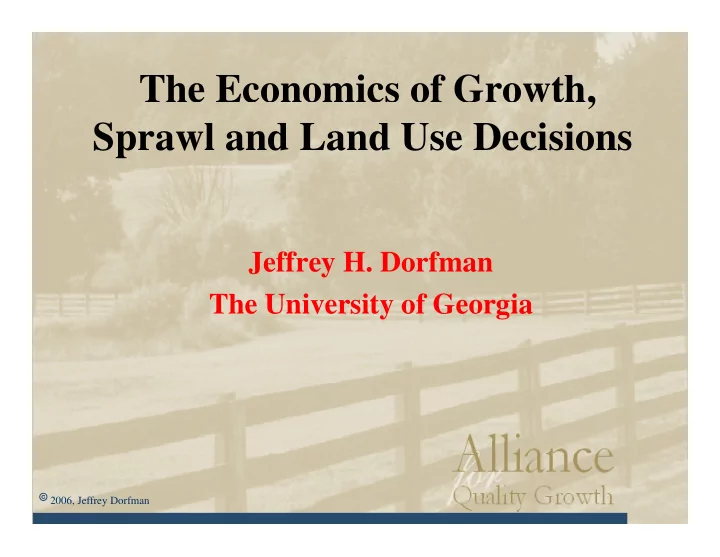

The Economics of Growth, , Sprawl and Land Use Decisions Jeffrey H. Dorfman The University of Georgia The University of Georgia 8 2006, Jeffrey Dorfman
Other Resources • To see similar slides to those printed here and To see similar slides to those printed here and other graphs, reports, and resources on the economics of growth and land use you can use economics of growth and land use, you can use the web at: www.arches.uga.edu/~jdorfman/ or landuse.uga.edu g 8 2006, Jeffrey Dorfman
Why Manage Growth? y g • Some growth will come to your city or Some growth will come to your city or county whether you want it or not. • Some growth won’t come to your city or county no matter what you do. h d • Then there is a middle ground you can impact p – This part will decide your fate 8 2006, Jeffrey Dorfman
Economic Benefits of Farm and Forest Lands • These lands produce valuable products for • These lands produce valuable products for consumers, generate jobs and tax revenues – 1/6 of all jobs and gross state product in 1/6 f ll j b d t t d t i GA • These lands attract businesses and families • These lands also provide a net surplus to local • These lands also provide a net surplus to local government finances 8 2006, Jeffrey Dorfman
Economic Benefits of Green Space • Green spaces increase property values of surrounding land • Green and open spaces can provide p p p environmental amenities for free • If green spaces contribute to quality of life, you attract people and jobs to community p p j y 8 2006, Jeffrey Dorfman
Development by Type y y • Many counties and cities think that growth h M i d i i hi k h and development mean an increasing tax base and better financial health for the local base and better financial health for the local government. • Unfortunately a growing tax base is not enough to guarantee financial health you enough to guarantee financial health, you must get revenue to grow faster than expenditures. expenditures. 8 2006, Jeffrey Dorfman
Cost of Community Service y Studies • A cost of community service study analyzes the revenue collection and expenditure the revenue collection and expenditure burden by class of development • Common categories are: – residential – commercial/industrial – farmland/forestland/open space 8 2006, Jeffrey Dorfman
Revenues to Cost by Land Use y • Using results compiled by AFT, the national Using results compiled by AFT, the national averages are: – Residential: $0.87 – Commercial/Industrial: $3.45 – Farmland/Forestland/Open Space: p p $2.70 • These figures are $’s of revenue for each $1 g of expenditures. 8 2006, Jeffrey Dorfman
Some Southeastern US Results Revenue:Expenditure Ratios $3.50 $3.00 Oconee $2.50 Hall Thomas $2.00 Carroll Carroll $1.50 Jones Cherokee $1.00 Union (NC) $0.50 Leon (FL) $0 00 $0.00 Resid. Comm. Farm/for. 8 2006, Jeffrey Dorfman
Manufactured Housing Dollars of Revenue per $1 of Service Cost Dollars of Revenue per $1 of Service Cost $1.00 $0.80 Colquitt Grady Grady $0.60 $0 60 Hall $0.40 Mitchell Thomas Thomas $0.20 $0 00 $0.00 8 2006, Jeffrey Dorfman
Break-even Home Values 3 kids 3 kids 2 kids 2 kids Jones Carroll Cherokee 1 kid County 0 200 400 600 800 1000 1200 1000 $ 1000 $ 8 2006, Jeffrey Dorfman
Development Patterns • Development patterns have an impact on the Development patterns have an impact on the cost of service delivery: sprawl is expensive to service to service. • The same growth done more densely and Th h d d l d contiguously saves both money, farmland, and provides environmental amenities. d id i l i i – New Jersey, South Carolina, California studies 8 2006, Jeffrey Dorfman
How to Change the Numbers g • Cost of service goes down by 50% of land Cost of service goes down by 50% of land savings (use half the land, save 25%). • Avoid leapfrog development • Avoid leapfrog development. • Build where infrastructure already exists (infill is much cheaper than extensive growth). (i fill i h h h i h) • Multifamily is less expensive per unit until density gets very high. • Design so service costs are low. g 8 2006, Jeffrey Dorfman
Possible Government Tools • Zoning • Standards • Standards • Impact fees • Incentives (time, I ti (ti approval, differential fees) fees) • TDRs • PDRs PDR • Time • Infrastructure 8 2006, Jeffrey Dorfman
Jobs, Commuting, and Home g • 31% if workers in Rural South work in a 31% if workers in Rural South work in a different county than where they live. • 52% of employment growth in metro areas 52% of employment growth in metro areas was from in-commuters. • 27% of employment growth in rural areas 27% of employment growth in rural areas was from in-commuters. • This means jobs may not equal housing This means jobs may not equal housing growth, but also that housing can grow without new jobs. j • Source for this slide is Mitch Renkow, NC State 8 2006, Jeffrey Dorfman
Growth Patterns and Job Creation • Sociologists are finding that today more and more high skill workers are choosing where to live first, g g then finding jobs. • Because businesses want high skill workers, they follow these workers to places with good quality of life of life. • If you attract good workers, good jobs follow . If you attract good workers, good jobs follow . 8 2006, Jeffrey Dorfman
Balanced Growth a Must • The real conclusion is • Local governments must ensure balanced growth, as sprawling balanced growth, as sprawling residential growth is a certain ticket to fiscal ruin*. * Or at least big tax increases. 8 2006, Jeffrey Dorfman
Recommend
More recommend